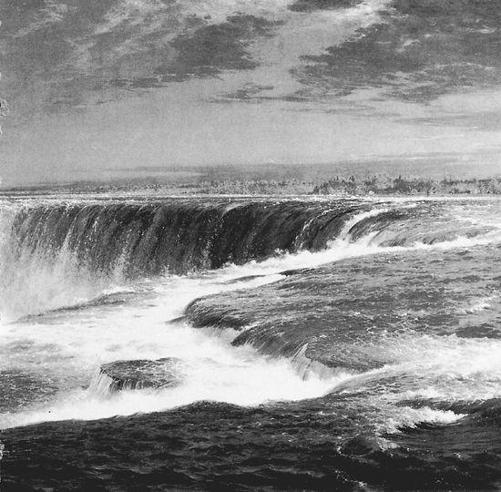Niagara: A History of the Falls (58 page)
Read Niagara: A History of the Falls Online
Authors: Pierre Berton

An advertisement of the Great Western & Michigan Central shows off Roebling’s famous bridge. The painting below was made about the same time by an anonymous artist. The railways made the Falls a tourist centre.
Black-and-white reproduction does not do justice to Frederic Edwin Church’s great painting showing the full sweep of the Horseshoe Falls from the very edge of the water. The Terrapin Tower can be seen in the background, left.
The early days of tourism,
circa
1860. The hackman poses his fares not far from the two hotels at Table Rock. The Luna Falls (also known as the Bridal Veil Falls) can be seen on the right.
This daguerreotype, made about 1853, shows tourists at Prospect Point standing above the lip of the American Falls.
To go “behind the sheet” in 1879, oilskins were provided – at a price –though many an unwary tourist thought they were free.
The great Blondin, balancing pole in hand, skips lightly across Niagara’s gorge – for him, it was no more dangerous than a country stroll.
Blondin’s great rival, Bill Hunt, a.k.a. Signor Farini, hangs by his heels from the slack wire.
As a crowd of spectators watches from the bank, above, Charles Blondin calmly reads a newspaper high above Niagara’s torrent. Note the guy wires in the background.
Saul Davis’s notorious Table Rock Hotel, “the cave of the forty thieves,” overlooks the Horseshoe. His stairway down the gorge wall is just visible in the foreground of the photograph.
The famous “Front,”
circa
1862. Davis’s stairway is in the foreground; Barnett’s Museum is beyond Robertson’s pagoda. In the distance, right, is the Clifton House, where the élite always stayed.












